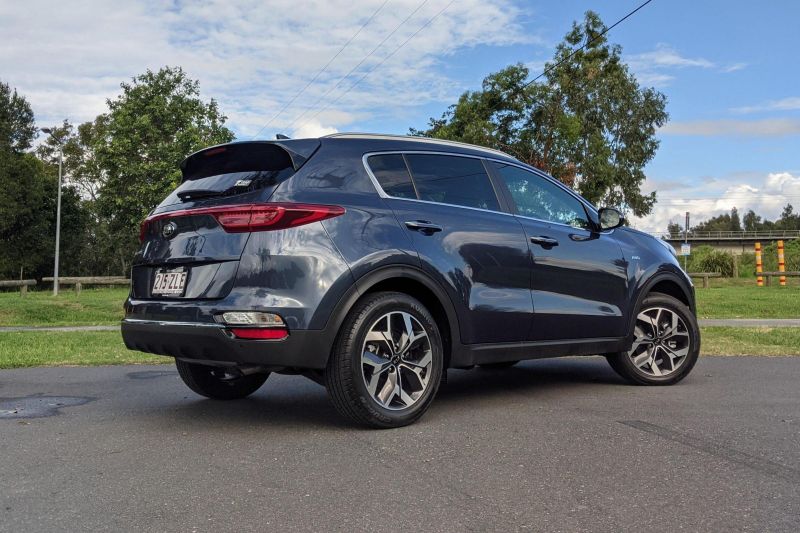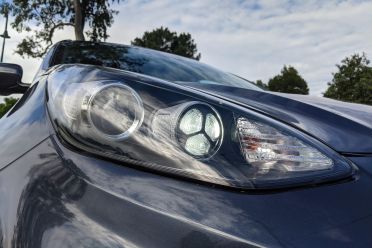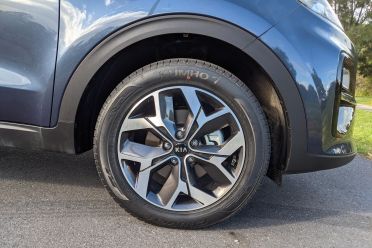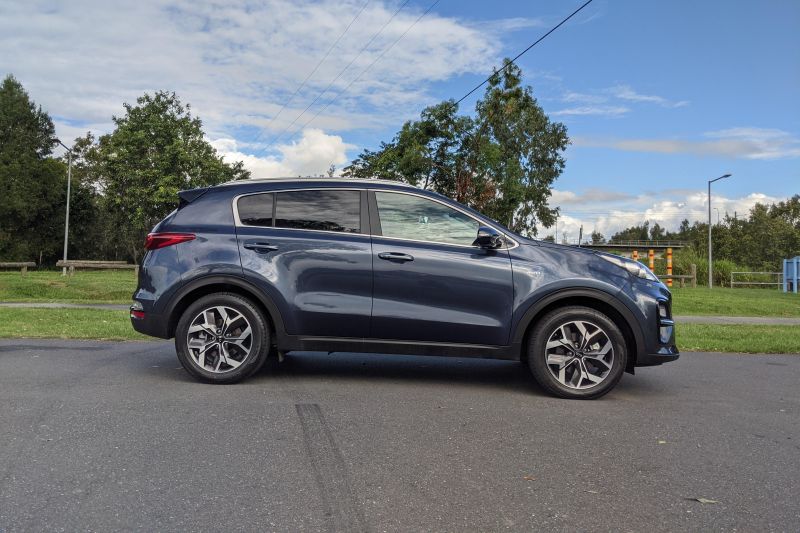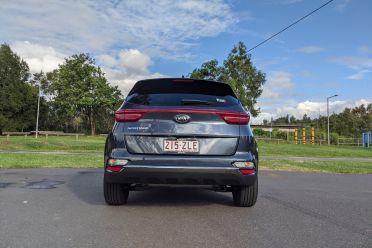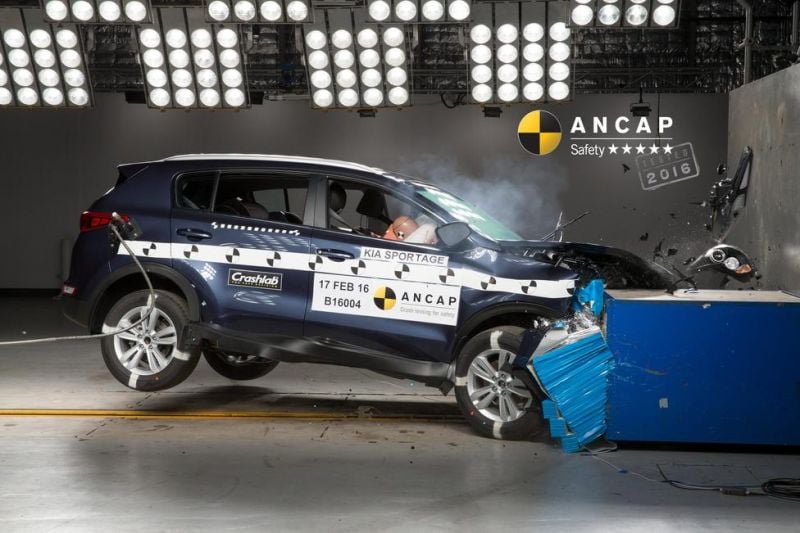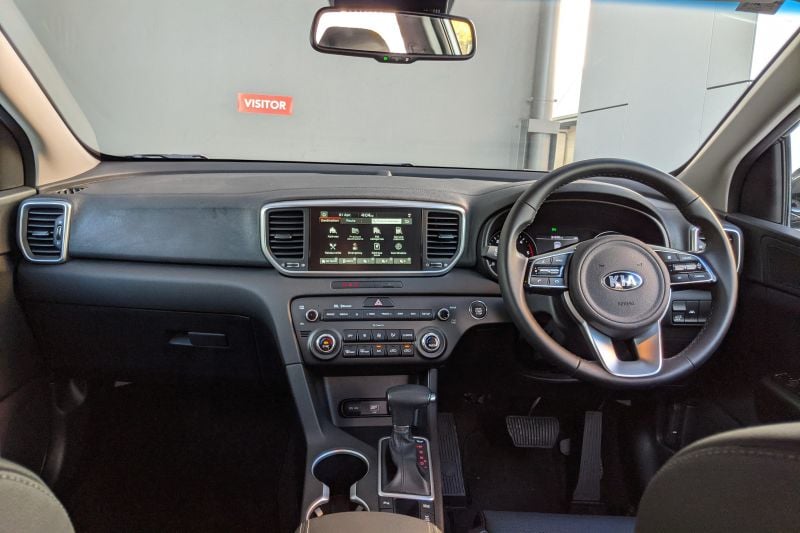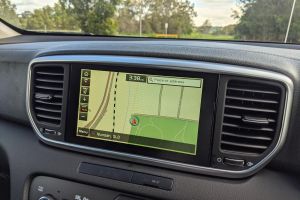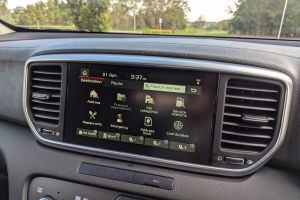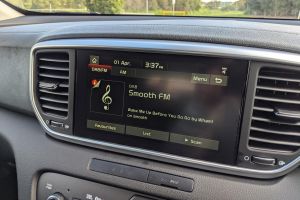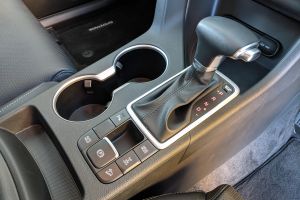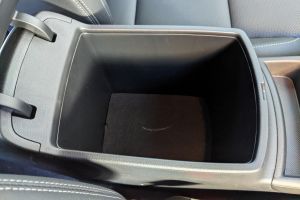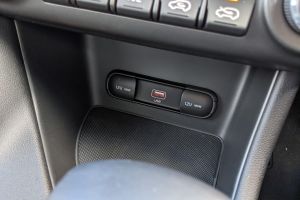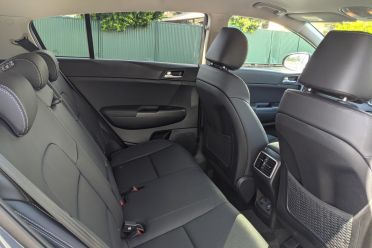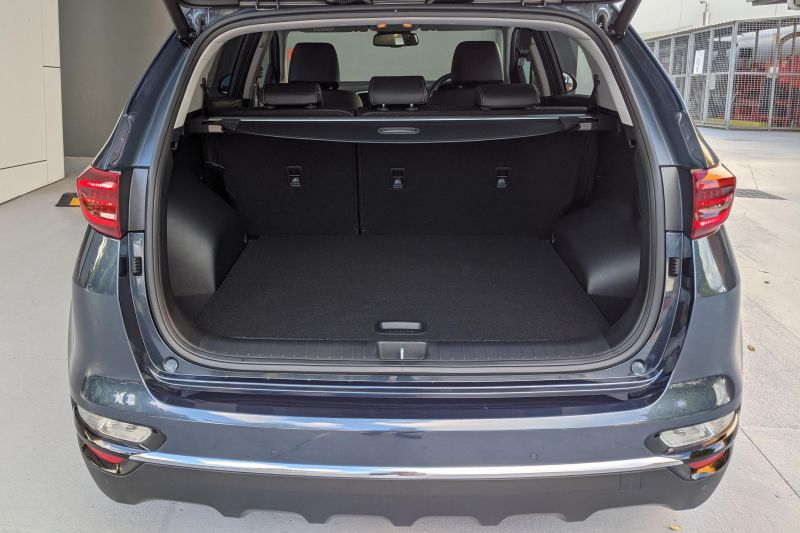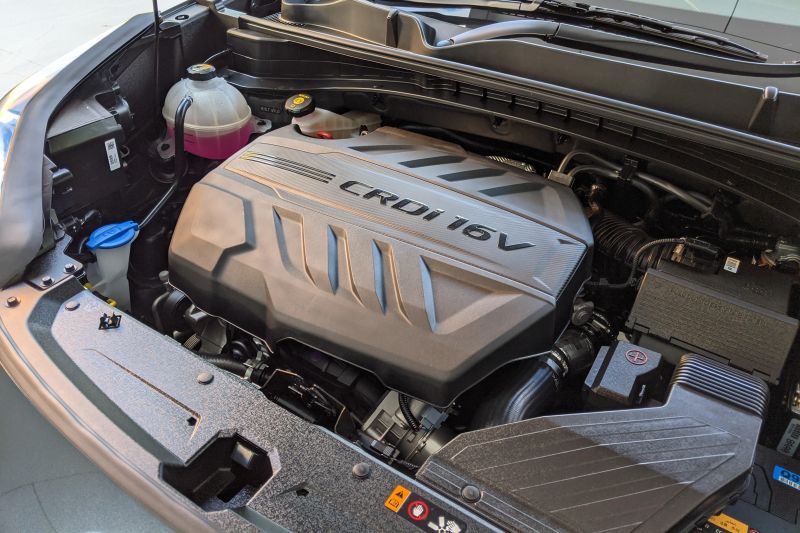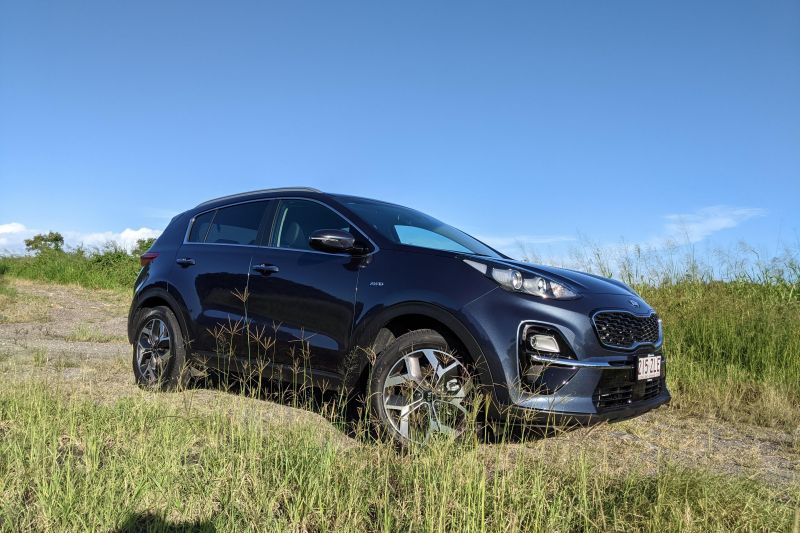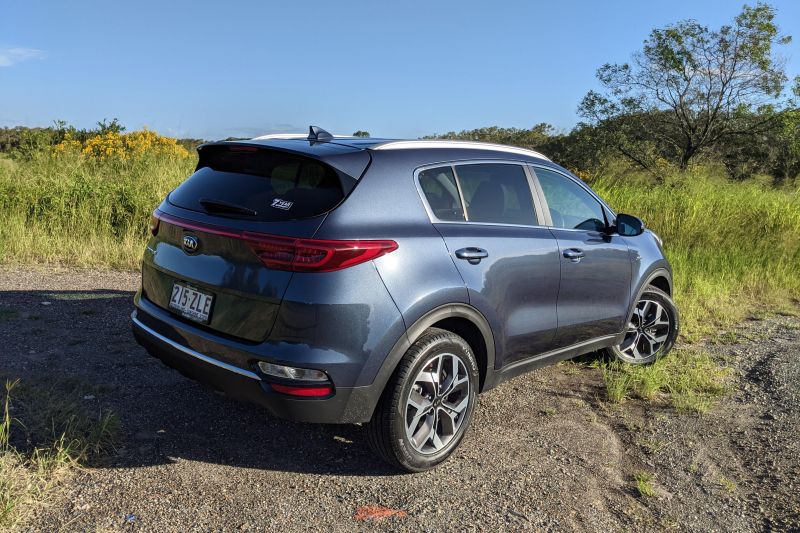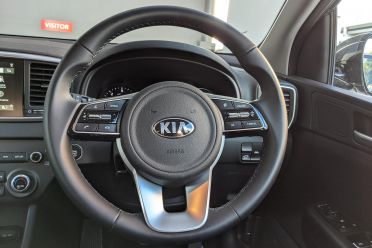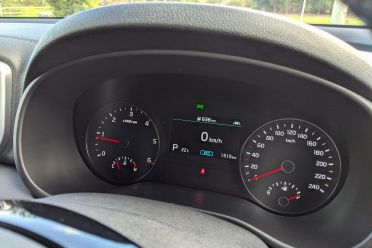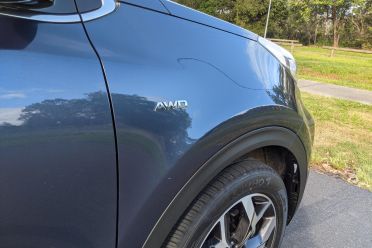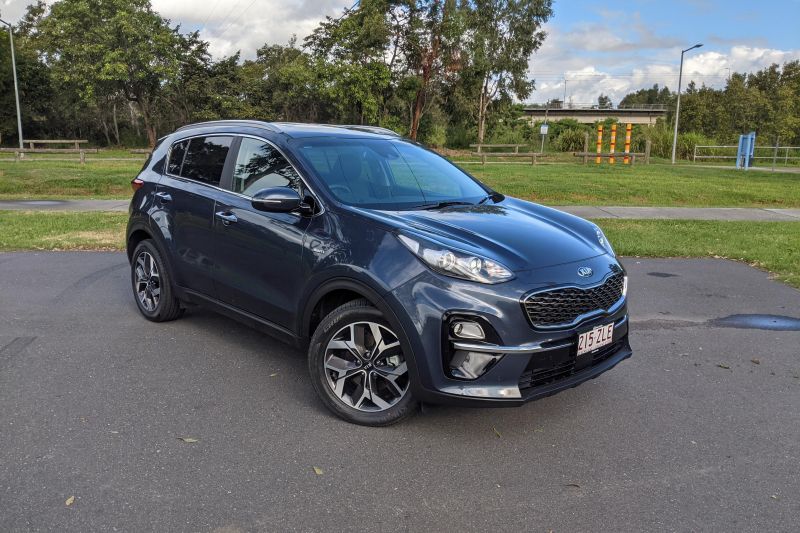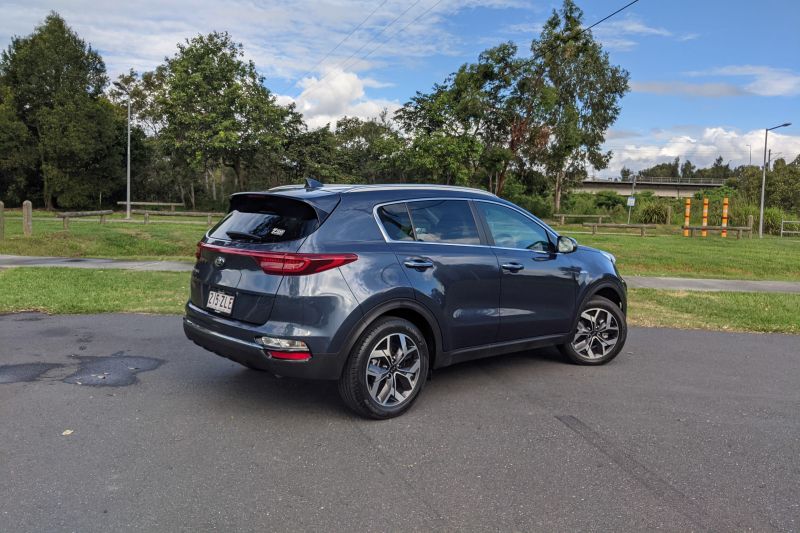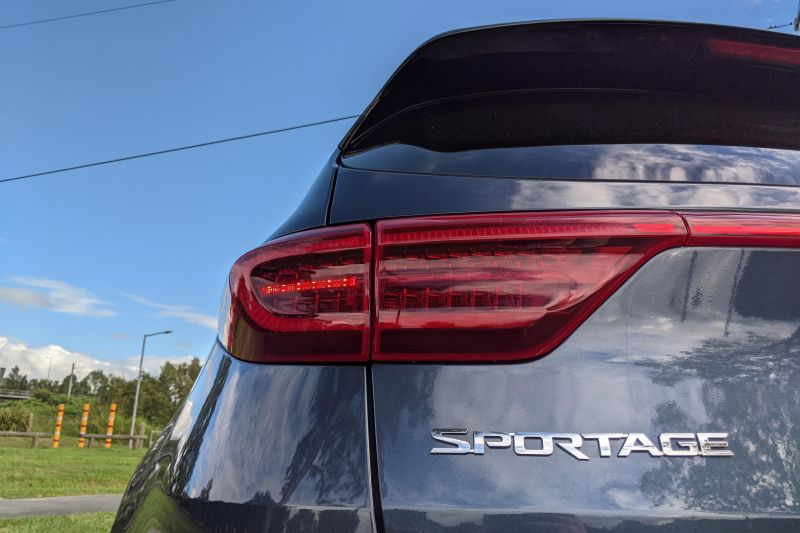If you think the mid-sized SUV segment is competitive now, just wait 6-12 months. We’ll have a new Kia Sportage then, plus redesigned versions of top-sellers like the Hyundai Tucson, Mitsubishi Outlander and Nissan X-Trail.
A large number of mid-sized SUVs on sale at the moment, therefore, are in the sunset of their lives. We haven’t seen what the redesigned Sportage will look like in its entirety, but we have a good idea what it’ll include – a similar engine range to the redesigned Tucson, a larger available touchscreen, larger exterior dimensions, and more sophisticated active safety technology.
It’s due here in the fourth quarter of 2021. That probably leaves you with a question: is it worth waiting for, or is the current Sportage still a good buy?
Let’s find out.

How much does the Kia Sportage SX+ Diesel AWD cost?
Kia has been incrementally increasing the prices of its model range over the past 12 months, and our all-wheel drive SX+ diesel tester is now sitting at $44,190 before on-road costs. Only the GT-Line petrol and diesel models are more expensive.
Kia is currently offering nationwide drive-away pricing of $47,290 for the vehicle you see here.
Comparing the list price of the SX+ diesel and SX+ petrol, there’s a significant $5400 gulf between the two. The diesel does, however, also include all-wheel drive while the petrol model is front-wheel drive.
What do you get?
Alas, this is where the Sportage shows its age. The newer Toyota RAV4 offers LED headlights, adaptive cruise control, blind-spot monitoring and rear cross-traffic alert across its entire range. To get those in a Sportage, you have to step all the way up to the top-spec GT-Line.
The SX+ is the cheapest Sportage to get the following:
- Keyless entry and start
- Leather upholstery
- 10-way power driver’s seat
- Power tailgate
- Rear privacy glass
- Tyre pressure monitoring
- 4.2-inch colour instrument cluster display screen
That’s in addition to features found lower in the Sportage range, such as:
- 8.0-inch touchscreen infotainment system
- Satellite navigation
- Wired Apple CarPlay and Android Auto
- 18-inch alloy wheels
- Reversing camera with front and rear parking sensors
- Eight-speaker JBL Premium sound system
- Automatic headlights, wipers and high-beam
- Dual-zone climate control
- Leather-wrapped steering wheel and shifter
- Tilt-and-telescoping steering column
There’s still the GT-Line above it, which adds features like a panoramic sunroof, wireless phone charging, heated and ventilated front seats, and semi-autonomous parking assist. To get that with a diesel, however, you’re looking at over $51,000 drive-away.
The outgoing Hyundai Tucson Elite diesel is better-equipped than the Sportage, offering adaptive cruise, blind-spot monitoring and rear cross-traffic alert and yet costing less at $43,500 before on-roads. Considering it features the same platform and powertrain, it’s the smarter buy though its warranty is shorter at five years versus the Kia’s seven.
Even the redesigned Tucson Elite diesel is $45,000 before on-roads, scarcely more than the Sportage while offering all these additional features plus active blind-spot assist and a larger 10.25-inch touchscreen.
The Mazda CX-5 Touring diesel also offers adaptive cruise, blind-spot monitoring and rear cross-traffic alert, albeit at a higher price of $44,280 before on-roads and without a power tailgate or power driver’s seat.
Nissan no longer offers an up-spec diesel X-Trail, while the Mitsubishi Outlander LS misses out on a few luxury niceties but offers blind-spot monitoring and rear cross-traffic alert yet only a $41,490 list price.
The elephant in the room is Australia’s best-selling SUV. While it doesn’t come with a diesel, the Toyota RAV4 can be had in hybrid, all-wheel drive GXL trim for $42,915 list, though you’ll give up a few convenience features like a power tailgate.
Is the Kia Sportage SX+ Diesel AWD safe?
The Sportage range wears a five-star rating from ANCAP, based on testing conducted in 2016.
That rating was based on a frontal offset score of 13.62 out of 16 and a side impact score of 16 out of 16. Whiplash and pedestrian protection were rated Good and Acceptable, respectively.
The SX+ comes standard with the following safety features:
- Autonomous emergency braking with forward-collision warning
- Lane-keeping assist
- Driver attention monitoring
- Anti-lock brakes
- Front, front side and curtain airbags
Features available on cheaper but newer Hyundai and Kia products, like blind-spot assist, rear cross-traffic assist and lane-following assist, aren’t available on the Sportage. The autonomous emergency braking system is also a simpler one, lacking newer features like junction assist. We fully expect these to be available on the redesigned range.
What is the Kia Sportage SX+ like on the inside?
The Sportage’s interior is ageing better than those of rivals like the Mitsubishi Outlander and Nissan X-Trail.
You’ll find a lot of the same switchgear as in the Hyundai Tucson, though the Sportage has a different and arguably more aesthetically-pleasing dashboard layout. Both models feature stitching elements on their soft-touch dash tops but the Sportage has neat, metal-look toggle switches on its steering wheel.
The Sportage’s shifter feels good in your hand with its T-shaped head – remember when car companies used to tout their “T-Bar Autos”? – while the leather-wrapped steering wheel is also pleasantly tactile.
Though even the cheaper Seltos is available now with a 10.25-inch touchscreen, the SX+’s 8.0-inch unit is still an acceptable size for this class.
Unlike some newer crossovers like the smaller Seltos and even, to some degree, the outgoing Tucson, the Sportage’s touchscreen doesn’t resemble a tablet jutting out of the dash top. Nevertheless, it’s positioned nice and high and is therefore easy to see and reach.
It’s still running Kia’s older user interface, so there are no neon pinks and purples and the maps don’t look quite as crisp. Still, even last-generation Kia infotainment systems are responsive, neat in appearance and easy to navigate. There’s a helpful row of hard shortcut buttons located between the touchscreen and the climate controls.
As soon as you go below the touchscreen, plastics shift from soft-touch to hard if hard-wearing and pleasant to look at.
We’d love a little contrast in the cabin, though – everything is black-on-black, with only thin slivers of satin chrome trim around the touchscreen, shifter and cupholders to liven things up. The GT-Line’s available two-tone interior is sorely missed.
There’s a relatively spacious centre console bin plus a small rubberised shelf at the base of the centre stack, though there’s no wireless charging pad in the SX+.
The analogue instruments are clear and easy to read, and flank a 4.2-inch colour screen. It’s a bit on the small side, though lesser Sportage models make do with an even smaller 3.5-inch monochromatic one.
The seats are comfortable enough, though they’re a bit firm and the leather isn’t very, shall we say, leathery.
There was a slight rattling sound that would occasionally emanate from the driver’s footwell, but otherwise the Sportage was rattle-free and felt solidly built. We also appreciate the lack of button blanks, with the only blank switches located to the right of the steering wheel.
The rear of the cabin has ample headroom and legroom for the mid-sized SUV class. The back seat can also be reclined for comfort or folded 60:40 for cargo.
Rear seat occupants enjoy rear air vents, a USB port and a 12V power outlet, plus large bottle holders in the doors and a fold-down centre armrest with cupholders.
There are three anchor points and two ISOFIX points for child seats.
The front seatbacks are finished in hard plastic, though they’re scooped out to improve knee room and include nets for storage.
Cargo volume is a bit lower than rivals like the RAV4, with a quoted 466L.
This expands to 1055L with the rear seats folded – for reference the new Tucson quotes more than 1800L. A full-size spare is located under the load floor.
What’s under the bonnet?
Powering our tester is the optional 2.0-litre four-cylinder turbo-diesel, producing 136kW of power and 400Nm of torque.
That’s up 22kW and a staggering 208Nm of torque over the base 2.0-litre petrol, while braked towing capacity also increases from 1600kg to 1900kg with a max towball download rating of 100kg.
All diesel Sportage models come exclusively with all-wheel drive and an eight-speed automatic transmission.
Some rivals, like the Nissan X-Trail, are shifting away from diesel engines. We expect the next Sportage to continue to offer one, though, as its redesigned Tucson cousin does.
How does the Kia Sportage SX+ Diesel AWD drive?
The Sportage’s electrically-assisted steering is light, though a touch vague. If you’re too heavy on the throttle, you may also find the Kumho tyres chirping as you power out of a roundabout.
Otherwise, the Sportage’s driving manners have stood the test of time. The light steering makes the Sportage easy to manoeuvre around town, and the Sportage’s handling is neutral and fuss-free.
More impressively, the Sportage has a polished feel to its ride. There’s good bump absorption and, overall, a classy feel to the way the Sportage dispatches ruts and imperfections.
There’s very little in the way of diesel clatter to endure once you’re ensconced in the Sportage’s interior. If your only experience with diesels has been in dual-cab utes, you’ll be pleasantly surprised.
Only if you really wring the Sportage’s neck will you have to endure diesel clatter, and even then it’s hardly thrashy. Meanwhile, tyre and wind noise never reach objectionable levels, even at highway speeds.
There’s only a touch of turbo lag off the line before you can enjoy the Sportage’s meaty diesel torque. You won’t need to push the Sportage diesel as much as you would a petrol-powered one and the eight-speed automatic shifts smoothly – we never felt the need to try the paddle shifters.
Quite simply, this is the best powertrain in the local Sportage range, though sometimes we wonder about the turbocharged petrol four offered elsewhere…
The absence of adaptive cruise control is disappointing at this price point, and the regular cruise control in the Sportage is no prize as it had trouble keeping the car at its set speed at times. Crossing the admittedly quite steep Gateway Bridge in Brisbane, the cruise control got to 10km/h over the set speed on the downhill approach.
While we’d love the intervention of adaptive cruise control, we could stand a touch less intervention from the lane-keeping assist. It can at times be intrusive, letting its presence be felt.
The flipside to that is it does a good job keeping you within your lane, though newer Kia products with their dual lane-keeping and lane-following assist systems offer a better balance overall.
While the Sportage isn’t designed for heavy bush-bashing, there’s an AWD Lock mode you can activate via switch on the centre console should you want some extra traction on a muddy trail. The car will shift back into AWD Auto mode above 30km/h, but will return to AWD Lock if you decelerate.
How much does the Kia Sportage SX+ Diesel AWD cost to run?
Over a mix of inner-city, suburban and highway driving, we averaged an indicated 6.9L/100km. During our time overall with the Sportage, that increased only slightly to 7.1L/100km – neither is far off the Sportage’s official rating of 6.4L/100km.
The Sportage requires servicing every 12 months or 15,000km, whichever comes first.
Kia offers seven years of capped-price servicing in addition to its seven-year, unlimited kilometre warranty.
The first seven services cost $367, $570, $425, $817, $413, $680 and $438. That works out to an average cost per service is $530, compared to $401 with the base 2.0-litre petrol and $420 for the 2.4-litre petrol.
That’s slightly higher than rivals like the Mitsubishi Outlander diesel, which costs an average of $499 over seven years and features identical intervals.
A Mazda CX-5 diesel costs an average of $375 to service over the same time, though it has shorter 12-month/10,000km intervals.
CarExpert’s Take on the Kia Sportage SX+ Diesel AWD
It isn’t on the road or inside the cabin where the Kia Sportage is finally feeling its age.
The Kia still rides in a polished way, while its diesel powertrain is both torquey and refined. The interior could do with some more contrast but the switchgear still looks and feels good and the design is pleasant.
Where the Sportage shows its age is on its spec sheet. It’s missing the latest generation of safety features on offer from Kia, a company that’s been aggressively rolling out more and more sophisticated safety features like active blind-spot assist that many rivals don’t yet offer.
The Sportage is also missing features like adaptive cruise control in this trim level, which you can get on even an entry-level Toyota RAV4. That’s disappointing for an SUV that costs over $40,000.
Also disappointing is Kia’s continued insistence on reserving LED headlights for only top-spec models (see: Cerato, Seltos). We expect some of these omissions will be addressed in the SX+ equivalent trim of the next-generation model.
You’ll have to decide whether you can justify the added expense of the diesel powertrain. There’s no doubt in our minds the diesel is a vastly better powertrain than the Sportage’s petrol engines and it also comes with all-wheel drive, but the SX+ diesel still costs a cool $5400 more than an SX+ petrol.
We’ve seen the next-generation Hyundai Tucson go up in price compared to the outgoing model, so it seems likely the Sportage will do the same.
There could be run-out deals to be had closer to the launch of the new model, but with that said, the outgoing Tucson is in run-out mode and you can get more kit for the same price. That’s where we’d be looking.





